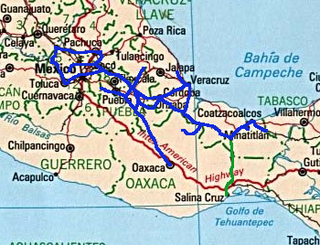
Tuxtla Gutiérrez, or Tuxtla, is the capital and the largest city of the Mexican southeastern state of Chiapas. It is the seat of the municipality of the same name, which the most developed and populous in the state. A busy government, commercial and services-oriented city, Tuxtla had one of the fastest-growing rates in Mexico over the last 40 years. Unlike many other areas in Chiapas, it is not a major tourist attraction, but a transportation hub for tourists coming into the state, with a large airport and a bus terminal.

The Tehuantepec jackrabbit is a jackrabbit endemic to Mexico.

The Ferrocarril del Istmo de Tehuantepec, also known as Tren Interoceánico, Line Z, Ferrocarril Transístmico or simply Ferroistmo, is part of the Interoceanic Corridor of the Isthmus of Tehuantepec, owned by the Mexican government, that crosses the Isthmus of Tehuantepec between Puerto Mexico, Veracruz, and Salina Cruz, Oaxaca. It is leased to Ferrocarril del Sureste FERROSUR.

Istmo de Tehuantepec is the largest region of the state of Oaxaca, located in southwestern Mexico.
The 2010 edition of the Carrera Panamericana Mexican sports car racing event started in Tuxtla Gutiérrez, Chiapas and finished in Zacatecas, Zacatecas. This edition was composed of seven stages and one day of qualification. Harri Rovanpera won this edition, in his first attempt. Jouni Närhi was his co-driver. Michel Jourdain Jr. was the runner up.
Federal Highway 305D is a toll highway in Quintana Roo. It serves as a spur of Federal Highway 180D (Mérida-Cancún) to Playa del Carmen, creating a direct connection between Yucatán and Playa del Carmen and avoiding detours through Cancún or Tulum.
Federal Highway 180D is the toll highways paralleling Highway 180 in seven separate segments of highway. Three are in Veracruz:, the Libramiento de Cardel, the highway from Cardel to Veracruz, and the Nuevo Teapa-Cosoleacaque highway. Four segments exist beyond Veracruz: one between Agua Dulce and Cárdenas, Tabasco, facilitating a connection from the city of Coatzacoalcos in Veracruz; a bypass of Villahermosa; one connecting Champotón to Campeche City, Campeche; and another connecting the cities of Mérida, Yucatán, and Cancún, Quintana Roo. An additional segment, connecting the latter highway to Playa del Carmen, is officially part of Highway 180D, but is signed as Highway 305D.
Federal Highway 70D is the designation for toll highways paralleling Mexican Federal Highway 70.

Federal Highway 117D is the designation for two toll highways in eastern Mexico.
Federal Highway 95D is a toll highway connecting Mexico City to Acapulco, Guerrero. Highway 95D is among the most important toll roads in the country, serving as a backbone for traffic out of Mexico City toward Morelos and tourist destinations in Guerrero.
Federal Highway 200D is the toll highways paralleling Fed. 200, and has two separate improved segments of designated roadway. Fed200D in Colima funnels traffic from Manzanillo toward Fed. 110 to the city of Colima; the segment in Guerrero serves as a bypass of Tecpan.
Federal Highway 80D is the designation for toll highways paralleling Mexican Federal Highway 80. There are two such roads, one between Zapotlanejo and Lagos de Moreno, Jalisco and the other connecting Lagos de Moreno to San Luis Potosí City.
Federal Highway 150D is a toll highway connecting Mexico City to Veracruz City via Puebla City and Córdoba. It serves as one of the backbones of Mexico's toll road system. The road is primarily operated by Caminos y Puentes Federales, which charges cars 520 pesos to travel Highway 150D, with one segment in the Puebla metropolitan area built and maintained by OHL and PINFRA.
Federal Highway 15D is the name for toll highways paralleling Federal Highway 15. The toll segments of Highway 15D include some of the most significant highways in the country along the Nogales-Mexico City corridor. The highway is the southern terminus of the CANAMEX Corridor, a trade corridor that stretches from Mexico north across the United States to the Canadian province of Alberta.
Federal Highway 40D is the designation for toll highways paralleling Mexican Federal Highway 40. Highway 40D connects Mazatlán, Sinaloa to Reynosa, Tamaulipas. It forms most of the highway corridor between Mazatlán and Matamoros, Tamaulipas, one of 14 major highway corridors in the country.
Federal Highway 45D is a toll road alternative to the paralleling Fed. 45. Eleven separate tolled segments exist of Fed. 45D between Querétaro City and Villa Ahumada in Chihuahua, between Chihuahua City and Ciudad Juárez.
Federal Highway 132D is the designation for toll highways paralleling Mexican Federal Highway 132. Highway 132D forms most of the Mexico City-Tuxpan highway corridor, with contiguous segments in the State of Mexico and from Tulancingo, Hidalgo to Tihuatlán, Veracruz.
Federal Highway 57D (Fed. 57D) is a tolled (cuota) part of the federal highways corridor of the paralleling Fed. 57. Eight separate tolled segments exist of Fed. 57D between Mexico City and Allende, Coahuila; a ninth is part-federal and part-state.
Line K, also known as the Ixtepec–Ciudad Hidalgo Line, is a railroad owned by the Mexican government that connects Ixtepec, Oaxaca with Ciudad Hidalgo, Chiapas. It was leased to the Ferrocarril Chiapas-Mayab. President Andrés Manuel López Obrador announced that the Mexican government will rehabilitate the line from Ixtepec, Oaxaca to Ciudad Hidalgo, Chiapas.

The Interoceanic Train of the Isthmus of Tehuantepec is a government-owned railway system in Mexico that has 3 lines. It seeks to become a global logistics network focused on the manufacture and movement of goods between the Pacific Ocean and the Atlantic Ocean through the Isthmus of Tehuantepec.






